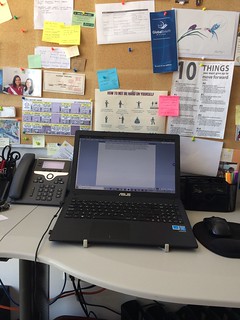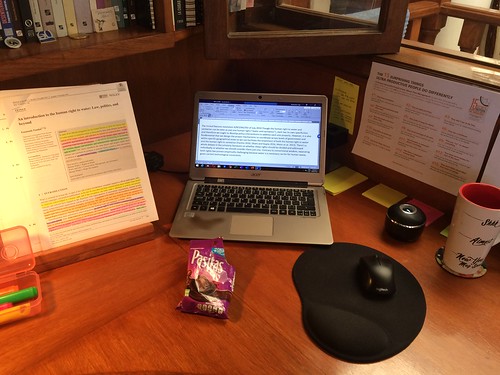Because of the COVID-19 lockdown, I have been working from home now basically every day. Since I’m staying at my Mom’s for the duration of the shelter-in-place period, and I have a full-fledged home office complete with bookshelves, desks and a desktop computer, printer, and wireless internet, I have been able to focus a bit more on writing than when I’m back in Aguascalientes and I go to campus on a daily basis.
At the same time, I still have many pending deadlines. My psoriasis-dermatitis-eczema set me back basically 7 months behind on everything. I have two particular manuscripts long overdue, and a couple of revise-and-resubmit resubmissions I need to send back. But one specific milestone that I cannot postpone is the delivery of my coauthored water conflicts book. This particular manuscript had to be delivered before April 11th, 2020, so I have been writing non-stop. As I was finishing up, I realized that this process felt a lot like when I was completing my doctoral dissertation. I therefore wrote a Twitter thread that I am transcribing in this blog post. My advice is very similar to what I suggested when I described my process to generate a full first draft of a paper or article in 8 steps. Basically, I write in bits and pieces (memorandums) and then I assemble the entire manuscript once it takes reasonable shape.
But assembling this one reminded me of my experience finishing my doctoral dissertation. This post explains the roadblocks I faced too.
1) Assemble the entire document as soon as humanly possible.
I wrote my dissertation (and this is a co-written book) in bits and pieces. Therefore, a lot of what I have been doing with this book is ASSEMBLING. Assemblage refers not only to the process of copying and pasting, but also making sure that the text has coherence. It needs to read approximately as though it’s the same voice (in the case of coauthored books). Making sure that the writing flows and that there is homogeneity in voices (or if it is an edited volume, that all chapters share the same Red Thread/Throughline) takes a lot of time and thinking.
2) Don’t leave ALL the formatting to the end.
This is a common mistake a lot of people make, not only me. One of the rationales for leaving all the formatting to the end is that “we don’t want to waste valuable creative writing time”. WRONG. I spent WEEKS formatting tables, graphs, diagrams, headers, footers, headings. What’s taking me A LOT OF TIME with this book is the formatting, making sure it’s homogeneous throughout. Formatting includes making sure that all tables, graphs, maps, figures, illustrations are properly labeled. I spend an inordinate amount of time using the “Insert Title” function to label tables and figures and make sure that I can create a table of titles and a table of figures towards the end. I did this with my PhD dissertation, and now that I did it with the full water conflicts manuscript, I completely recalled what a pain this was.
3) Ensure that all the references are in your Mendeley (or Endnote, Zotero, Papers, Citavi, Refworks).
Reference cleaning and bibliography assembly are EXHAUSTING. I absolutely adore Mendeley and I have written both a handy guide on how to use it to write papers and a post on how I use the Cite-o-Matic function of Mendeley to “dialogue” with Word and insert references as I go. But having the discipline of reading, importing into Mendeley, and cleaning the reference, requires forethought and assigning time to this process. Otherwise, we end up spending hours uploading references we are missing. I am sure you all have done the “INSERT REFERENCE X HERE”. Yeah, I do that too. And if I don’t do it right there and then, I sometimes forget and then I have to spend an entire morning finding the piece in PDF format, uploading it to Mendeley and cleaning the reference.
4) Extract bits and pieces of each individual chapter’s conclusions and copy them into the final conclusion of the book.
Remember, the concluding chapter’s purpose is to say “these are the things we learned, and I did promise you you would learn these, so here they are”. With regards to conclusions, I’ve written before about how to write a concluding chapter for a book, and for a paper, but I also want to share wisdom that Dr. Pat Thomson shared as a response to my Twitter thread.
Conclusions also do So What Now What. The trick is to present these so you donít finish the text with new questions, but with the key results and their implications. Itís often hard to do this elegantly and finish with a flourish. Itís doesnít get easier.
ó pat thomson 🕷 (@ThomsonPat) April 5, 2020
5) Print the entire thing ONE TIME for editing purposes.
I know, suggesting that you should print out your document is a bit of a heresy. I’m an environmental politics specialist, but I can’t edit on screen, so I recommend doing ONLY ONE printout, pointing OUT the errors, and then cleaning them. After doing that, I don’t print a second copy. I just generate a PDF. I know that there are people who can edit on screen, but I cannot.
I just want to add one thought that came to me as I was writing this blog post: this is a stressful time. If you can or need to finish a book manuscript or a thesis, I do hope that these tips will be useful to you, but more than anything, I recommend that you be kind to yourself. Finishing up such a major piece of work is hard and takes a lot of energy and it’s a draining process, so make sure to take time off once you’re done.
Good luck!




0 Responses
Stay in touch with the conversation, subscribe to the RSS feed for comments on this post.